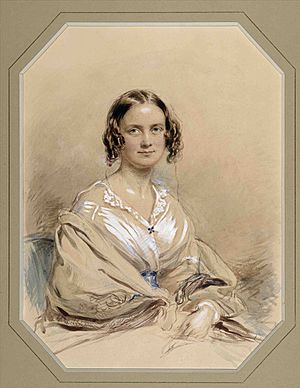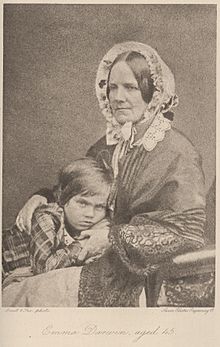Emma Darwin facts for kids
Quick facts for kids
Emma Darwin
|
|
|---|---|

Darwin in 1840
|
|
| Born |
Emma Wedgwood
2 May 1808 Maer, Staffordshire, England
|
| Died | 2 October 1896 (aged 88) |
| Resting place | St Mary's Church, Downe |
| Spouse(s) | |
| Children | 10, including William, Annie, Henrietta, George, Francis, Leonard and Horace |
| Parent(s) | Josiah Wedgwood II Elizabeth (Bessie) Allen |
Emma Darwin (born Wedgwood; May 2, 1808 – October 2, 1896) was an English woman. She is best known as the wife and first cousin of the famous scientist Charles Darwin. They got married on January 29, 1839. Emma and Charles had ten children together, and seven of them lived to become adults.
Contents
Emma's Early Life
Emma Wedgwood was born at Maer Hall in Maer, Staffordshire. She was the youngest of seven children. Her parents were Josiah Wedgwood II and Elizabeth "Bessie" Allen. Emma's grandfather, Josiah Wedgwood, became rich by making pottery. Her family belonged to the Unitarian church, which was a type of Protestantism different from the main Church of England.
Charles Darwin was Emma's first cousin. Their grandparents were Josiah and Sarah Wedgwood. Because the Wedgwood and Darwin families were very close, Emma and Charles knew each other since they were children.
Emma was very close to her sister Fanny. The family called them the "Doveleys." Emma was also known as "Little Miss Slip-Slop" because she was charming and a bit messy. She helped her older sister Elizabeth teach at a Sunday school. This school was held in the laundry room at Maer Hall. Emma wrote simple stories to help teach the 60 village children. This was often their only chance to learn reading, writing, and religion.
In 1818, when Emma was 10, her family visited Paris, France, for six months. She always remembered how interesting and new it was to be in a foreign country.
Emma's Education and Music
In 1822, when Emma was 13, she and her sister Fanny went to Mrs. Mayer's school in Paddington, London. Emma was already a very good piano player. She was even invited to play for King George IV's friend, Mrs. Fitzherbert. After this, Emma's older sisters and tutors taught her. She remained an excellent pianist her whole life. She even had piano lessons from famous musicians like Ignaz Moscheles and Frédéric Chopin.
In 1825, Emma's father took his daughters on a "grand tour" of Europe. They traveled through Paris to Geneva, Switzerland, to visit their aunt. The next year, Emma and Fanny stayed with their aunt near Geneva for eight months. When their father came to get them, their cousin Charles Darwin joined them in Paris before they all returned home in 1827. Emma also enjoyed outdoor activities like archery.
On August 31, 1831, Emma was with her family at Maer. They helped Charles Darwin convince his father to let him go on a long journey on the ship HMS Beagle. While Charles was away, his sisters sent him letters. They shared family news, including the sad news that Emma's sister Fanny had died at age 26.
Emma had turned down several marriage proposals before. After her mother became sick and couldn't leave her bed, Emma and her older sister Elizabeth spent a lot of time caring for her. Emma would spend several months each year away from home, staying with friends or family.
Marriage to Charles Darwin
Emma Wedgwood accepted Charles Darwin's marriage proposal on November 11, 1838. She was 30 years old. They got married on January 29, 1839, at St. Peter's Anglican Church in Maer. Their cousin, Reverend John Allen Wedgwood, performed the ceremony.
After living in London for a short time, they moved permanently to Down House. This house was in the quiet village of Down, about 16 miles (26 km) from St Paul's Cathedral in London. The village was later renamed Downe.
Charles and Emma raised their ten children in a very relaxed way. They were not strict parents. Several of their children became very successful in their careers. For example, George, Francis, and Horace became Fellows of the Royal Society, which is a very high honor for scientists.
Emma Darwin is remembered for her patience and strength. She cared for her husband, Charles, who had a long-term illness. She also nursed her children through many sicknesses. Sadly, she experienced the deaths of three of her children: Anne, Mary, and Charles Waring. By the mid-1850s, people in the village knew Emma for her kindness. She helped the poor by giving out bread tokens and small payments to the elderly. She also gave food and simple medicines to the sick, using her father-in-law's old prescription book.
In a letter from July 5, 1844, Charles Darwin asked Emma to publish his scientific work if he died suddenly. Luckily, Charles lived and published his famous book, On the Origin of Species, in 1859.
Emma's Religious Beliefs
Emma's religious beliefs were based on Unitarianism. This faith focuses on personal feelings and understanding, rather than strictly following religious texts or rules. Her beliefs were not simple. She thought deeply about them and questioned things.
Charles Darwin was open about his doubts about religion before they got engaged. Emma talked with him about her worries that their different beliefs might create a distance between them. But she also wanted to be close to him and share ideas openly. After they married, they often discussed Christianity for several years. Emma liked that Charles was honest about his uncertainty about God. His views slowly changed towards agnosticism, which means not knowing if God exists. This honesty might have helped them stay close, even with their different beliefs.
In 1838, before they were engaged, Charles Darwin told Emma about his ideas on how species change over time. About ten days later, Emma wrote him a letter. She said that when they were together, she didn't have sad thoughts. But when he was gone, she worried that their opinions on important subjects might be very different. She believed that honest doubts were not a sin. She thanked him for being open with her and said she would hate it if he hid his opinions from her. She also asked him to read a part of the Gospel of John in the Bible, which she loved.
Emma believed in an afterlife and wanted them to "belong to each other" forever. Even though Charles's beliefs changed over time, they remained open and honest with each other about their views. Emma believed that as long as Charles was trying to find the truth, he couldn't be wrong.
Later Life and the Darwin Homes
Charles Darwin died on April 19, 1882, when Emma was almost 74 years old. After his death, Emma spent her summers at Down House. During the winters, she lived in a large house called The Grove in Cambridge. Emma Darwin died in 1896.
Her son Francis built a house called Wychfield on the grounds of The Grove. He lived there during most winters. Another son, Horace, also built a house on the grounds and named it The Orchard.
Today, The Grove is the main building of Fitzwilliam College, Cambridge. It is used by students and teachers. There was a discussion about tearing down a smaller building called Grove Lodge, which was part of The Grove. But after many people expressed concern, the college decided to keep and fix up Grove Lodge. It was finished in 2011 and now has five new study rooms.
Darwin Children
- William Erasmus Darwin (1839–1914)
- Anne Elizabeth Darwin (1841–1851)
- Mary Eleanor Darwin (1842)
- Henrietta Emma "Etty" Darwin (1843–1927)
- George Howard Darwin (1845–1912)
- Elizabeth Darwin (1847–1926)
- Francis Darwin (1848–1925)
- Leonard Darwin (1850–1943)
- Horace Darwin (1851–1928)
- Charles Waring Darwin (1856–1858)
After Charles Darwin died in 1882, Emma and her son Francis also raised Francis's son, Bernard Darwin (1876-1961). Bernard's mother had died a few days after he was born.
Darwins Buried at Downe
Eight members of the Darwin family are buried at St Mary's Church, Downe. These include:
- Bernard Darwin and his wife Elinor Monsell
- Charles Waring Darwin
- Elizabeth Darwin (known as "Aunt Bessy")
- Emma Darwin, Charles Darwin's wife
- Erasmus Alvey Darwin
- Mary Eleanor Darwin
- Henrietta Etty Darwin, later Litchfield (known as "Aunt Etty")
Emma Darwin's sister Elizabeth Wedgwood and Aunt Sarah Wedgwood are also buried together at St Mary's Church.
See also
 In Spanish: Emma Darwin para niños
In Spanish: Emma Darwin para niños
- Social history of the piano
- Emma Darwin (novelist)
- List of coupled cousins
- Darwin–Wedgwood family
- Emma Darwin: A Century of Family Letters


